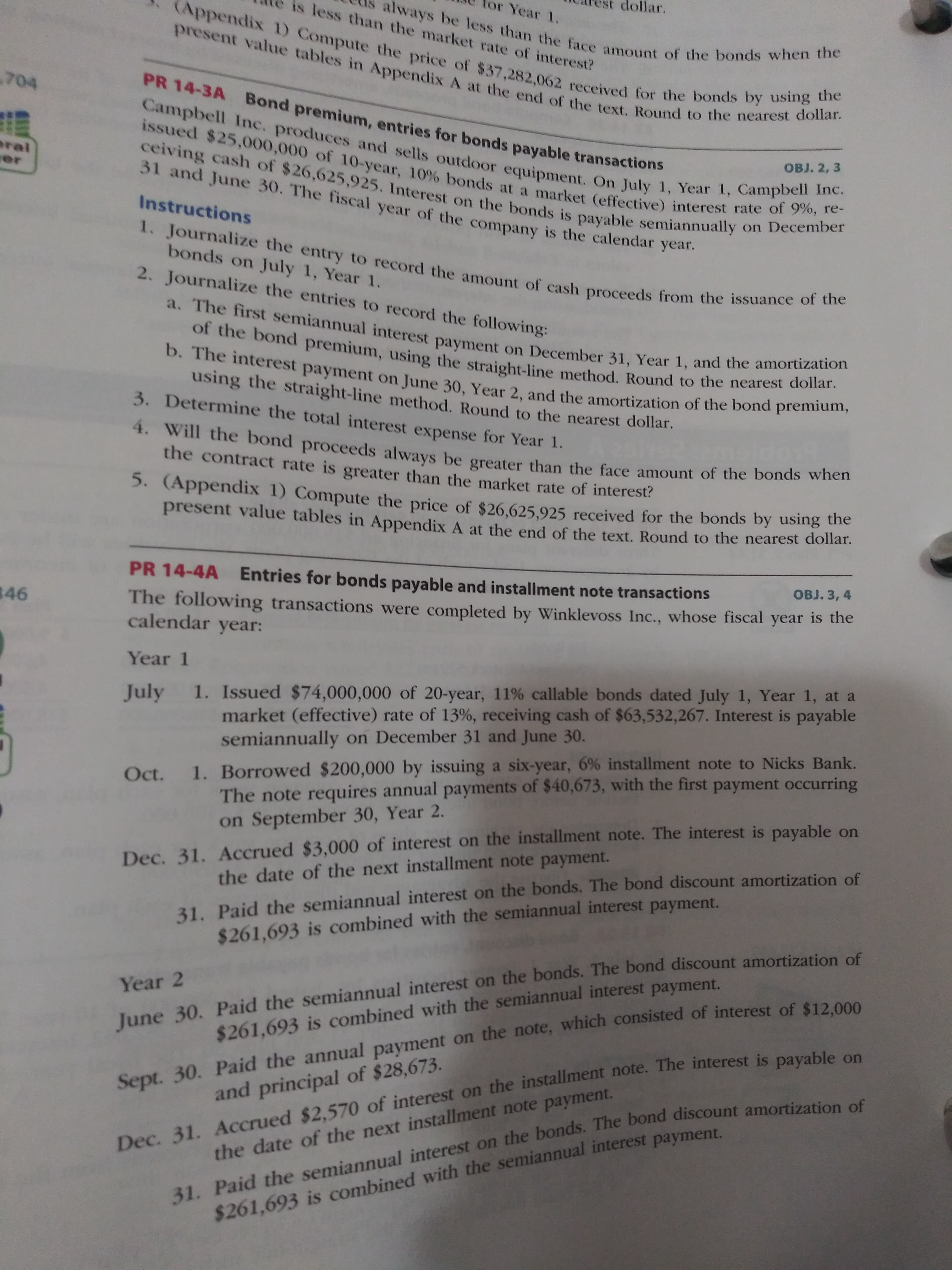for the bonds by using the end of the text. Round to the nearest dollar. Bond premium, entries for bonds payable transactions оBJ. 2, 3 Campbell Inc. produces and sells outdoor equipment. On July 1, Year 1, Campbell Inc. issued $25,000,000 of 10-year, 10% bonds at a market (effective) interest rate of 9%, re- ceiving cash of $26,625,925. Interest on the bonds is payable semiannually on December 31 and June 30. The fiscal year of the company is the calendar year. Instructions 1. Journalize the entry to record the amount of cash proceeds from the issuance of the bonds on July 1, Year 1. 2. Journalize the entries to record the following: a. The first semiannual interest payment on December 31, Year 1, and the amortization of the bond premium, using the straight-line method. Round to the nearest dollar. b. The interest payment on June 30, Year 2, and the amortization of the bond premium, using the straight-line method. Round to the nearest dollar. 3. Determine the total interest expense for Year 1. 4. Will the bond prOceeds always be greater than the face amount of the bonds when the contract rate is greater than the market rate of interest? 5. (Appendix 1) Compute the price of $26.625,925 received for the bonds by usngllar present value tables in Appendix A at the end of the text. Round to the nearest dollar.
for the bonds by using the end of the text. Round to the nearest dollar. Bond premium, entries for bonds payable transactions оBJ. 2, 3 Campbell Inc. produces and sells outdoor equipment. On July 1, Year 1, Campbell Inc. issued $25,000,000 of 10-year, 10% bonds at a market (effective) interest rate of 9%, re- ceiving cash of $26,625,925. Interest on the bonds is payable semiannually on December 31 and June 30. The fiscal year of the company is the calendar year. Instructions 1. Journalize the entry to record the amount of cash proceeds from the issuance of the bonds on July 1, Year 1. 2. Journalize the entries to record the following: a. The first semiannual interest payment on December 31, Year 1, and the amortization of the bond premium, using the straight-line method. Round to the nearest dollar. b. The interest payment on June 30, Year 2, and the amortization of the bond premium, using the straight-line method. Round to the nearest dollar. 3. Determine the total interest expense for Year 1. 4. Will the bond prOceeds always be greater than the face amount of the bonds when the contract rate is greater than the market rate of interest? 5. (Appendix 1) Compute the price of $26.625,925 received for the bonds by usngllar present value tables in Appendix A at the end of the text. Round to the nearest dollar.
Chapter10: The Basics Of Capital Budgeting: Evaluating Cash Flows
Section10.4: Internal Rate Of Return (irr)
Problem 6ST
Related questions
Question
PR. 14-3 and PR. 14-4
EX. 15-16 and EX. 15-17

Transcribed Image Text:for the bonds by using the
end of the text. Round to the nearest dollar.
Bond premium, entries for bonds payable transactions
оBJ. 2, 3
Campbell Inc. produces and sells outdoor equipment. On July 1, Year 1, Campbell Inc.
issued $25,000,000 of 10-year, 10% bonds at a market (effective) interest rate of 9%, re-
ceiving cash of $26,625,925. Interest on the bonds is payable semiannually on December
31 and June 30. The fiscal year of the company is the calendar year.
Instructions
1. Journalize the entry to record the amount of cash proceeds from the issuance of the
bonds on July 1, Year 1.
2. Journalize the entries to record the following:
a. The first semiannual interest payment on December 31, Year 1, and the amortization
of the bond premium, using the straight-line method. Round to the nearest dollar.
b. The interest payment on June 30, Year 2, and the amortization of the bond premium,
using the straight-line method. Round to the nearest dollar.
3. Determine the total interest expense for Year 1.
4. Will the bond prOceeds always be greater than the face amount of the bonds when
the contract rate is greater than the market rate of interest?
5. (Appendix 1) Compute the price of $26.625,925 received for the bonds by usngllar
present value tables in Appendix A at the end of the text. Round to the nearest dollar.

Expert Solution
This question has been solved!
Explore an expertly crafted, step-by-step solution for a thorough understanding of key concepts.
This is a popular solution!
Trending now
This is a popular solution!
Step by step
Solved in 3 steps with 1 images

Knowledge Booster
Learn more about
Need a deep-dive on the concept behind this application? Look no further. Learn more about this topic, accounting and related others by exploring similar questions and additional content below.Recommended textbooks for you

